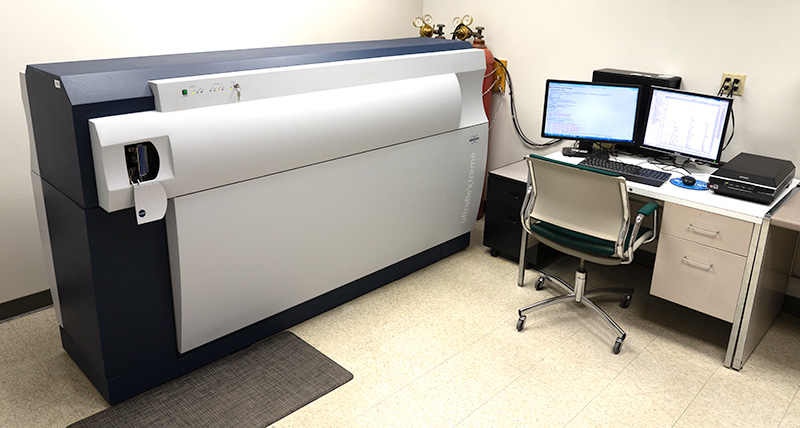Mass Spectrometry
The PCL provides a Bruker Ultraflextreme MALDI-TOF-TOF instrument that is used for proteomics and Imaging. The instrument is a high resolution and mass accuracy instrument that is capable of Top Down as well as Bottom Up protein ID using in house and on-line search engines and public databases. This instrument is only for limited students available.
Please contact us about schedule training.
pcl@ag.tamu.edu
Mass Determination
Protein/Peptide Mass Determination
The Protein Chemistry Laboratory performs mass analysis of proteins and peptides using matrix-assisted, laser-desorption ionization (MALDI) methods and time-of-flight (TOF) mass analysis and Electrospray Ion Trap mass spectrometry. WE DO NOT PERFORM ANALYSIS OF POLYNUCLEOTIDES OR OTHER BIOPOLYMERS. We recommend that you contact the Laboratory for Biological Mass Spectrometry in the Department of Chemistry at Texas A&M University for non-protein mass spectrometric analyses.
MS Mass Instrumentation
The PCL has a Bruker Ultraflextreme MALDI-TOF mass spectrometer equipped with delayed extraction and reflectron capabilities which is used for routine high mass accuracy analysis of peptides (<3 kDa). The instrument can also be operated in linear mode for protein analysis (>3 kDa). The Ultraflextreme is capable of Top Down and Bottom Up peptide mass fingerprinting. It is equipped with a 2 kHz laser that makes it also capable of Imaging Mass Spectrometry. The lab has all relevant software for mass measurement, MASCOT searching with BioTools and FlexImaging and SciLs software for image analysis.
Procedure for MALDI-TOF Analysis
In MALDI-TOF mass spectrometry, protein or peptide samples are mixed with a matrix compound (usually an aromatic organic acid that donates a proton to the analyte) and dried onto a metal sample plate. After the plate is placed in a high vacuum source chamber in the mass spectrometer, a small portion of the sample is vaporized (desorption) by blasts from a nitrogen laser. The ions produced ‘fly’ up a tube to the mass analyzer and their masses (actually their mass-to-charge ratio) are determined by their ‘time-of-flight’. The range of measurements using MALDI is in excess of 100 kDa although accuracy falls off at this size. The lower practical limits are several hundred Daltons as there is considerable interference in this range of the spectra from matrix and other low mass contaminants.
Procedure for Electrospray Mass Analysis
The ThermoScientific Exactive Orbitrap uses electrospray as an ionization source. Samples may be infused into the instrument using a syringe or applied directly into the instrument from an in-line HPLC system that separates peptides using reversed phase chromatography. Sample preparation is much more critical for this method than for MALDI-TOF mass spectrometry. It is very sensitive to sample media. Therefore, samples for infusion should be prepared in water, if possible, or in acetonitrile or methanol. Although tolerated at very low levels, trifluoroacetic acid is discouraged as an ion-pairing agent. Formic acid is suggested in its place. Please contact us for further information concerning sample preparation, amount and concentration electrospray mass spectrometry.
Typically, peptides below 2000 Daltons are amenable to this technique. Proteins above 2000 Daltons can be analyzed but with reduced success due to our lack of adequate deconvolution software. Proteins must be exquisitely free of salts, detergents and other contaminants to have any chance of success by this approach. MALDI-TOF mass spec is better suited to larger proteins.
Amount of Sample needed for Analysis
For routine mass analysis of single proteins up to 10kDa, we require 10µl of 1 micromolar (1µM) solution. Analysis of larger proteins (up to 80 kDa) requires proportionately more material and request that you supply 5-10 µl of a 10 µM solution. In all cases, the complexity of the sample must be considered and relatively more material supplied as the sample becomes more complex (i.e. more than one component).
In general, peak heights in MALDI spectra are not quantitative and do not accurately represent the relative abundance of the peptides or proteins in the mixture.
MS Sample Preparation
Mass analyzers are very sensitive and can measure femtomole amounts of purified material although the quality of the signal is directly related to the concentration and purity of the sample provided. MALDI is relatively less sensitive to the presence of contaminants such as salts or denaturants than other mass spectrometric methods (i.e. electrospray ionization). However, certain reagents are deleterious to sample analysis. This is particularly true of detergents and other non-volatile substances such as glycerol and dimethyl sulfoxide. If detergents are absolutely required, we recommend using n-octylglucoside as it does not interfere as much with the analysis as others. Sodium dodecyl sulfate is particularly deleterious as are the non-ionic detergents Triton and Tween and must be avoided.

